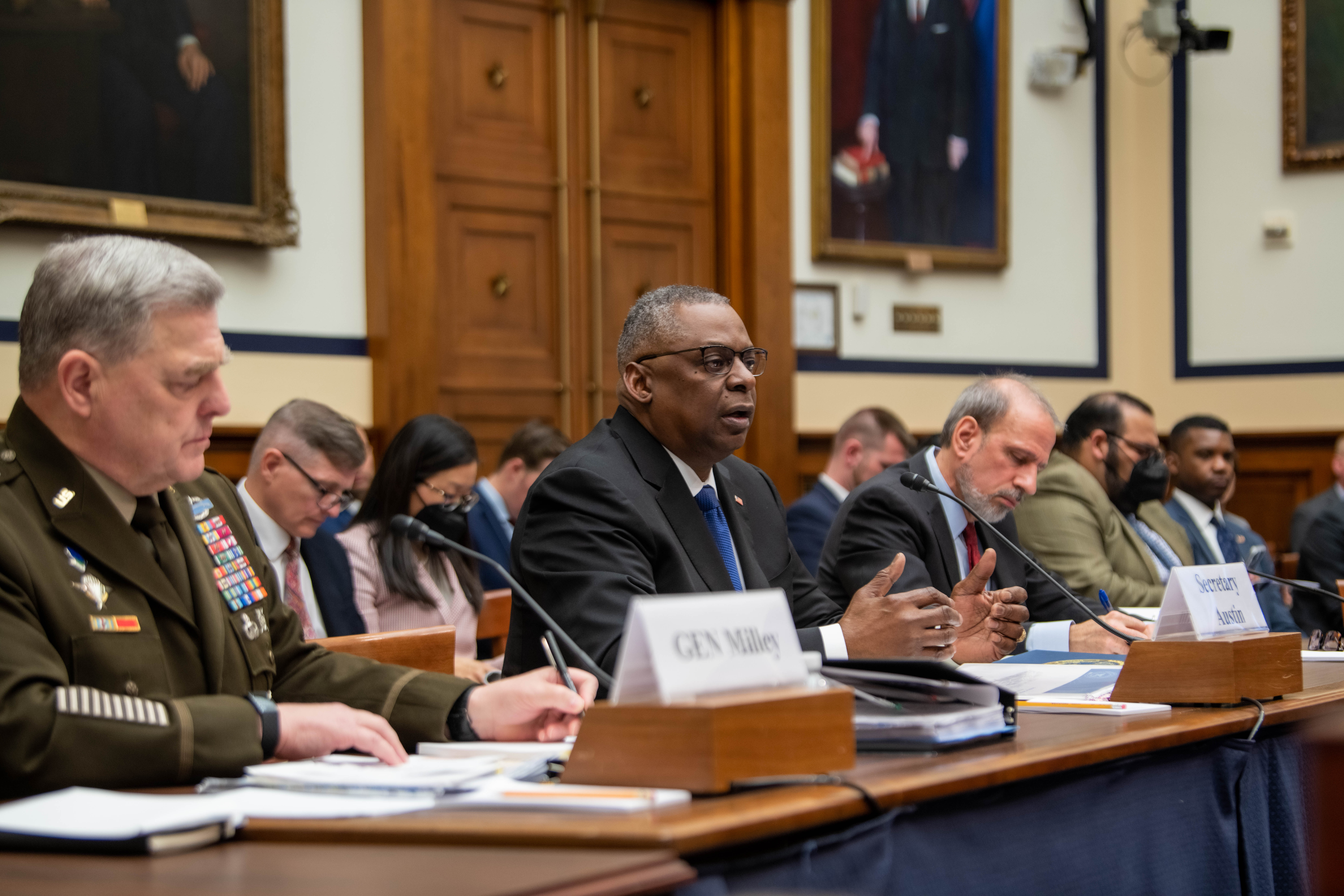With many lawmakers already pushing to increase the top line of the Pentagon’s fiscal 2023 budget, top defense officials acknowledged April 5 that their budget request was based off inflation rates that were “incorrect.”
At the same time, they argued, the $773 billion request would be enough to pursue the Defense Department’s goals of modernization to match the threat of China and Russia.
Defense Secretary Lloyd J. Austin III, Chairman of the Joint Chiefs of Staff Gen. Mark A. Milley, and Pentagon comptroller Michael J. McCord appeared before the House Armed Services for nearly five hours, defending their recently-released budget request as numerous representatives, both Republican and Democrat, questioned whether it was enough to keep pace with surging inflation and if proposed cuts to legacy systems were taking too great a short-term risk.
“Despite predictions from leading economists that record inflation will endure, the White House directed the Pentagon to assume a rate of only 2.2 percent for FY23,” said Rep. Mike Rogers (R-Ala.), the committee’s ranking member. “We’re now at 8 percent inflation. To get to an average of 2.2 percent next year would require months of unprecedented low inflation. Everyone here knows that’s not going to happen. Nearly every dollar of increase in this budget will be eaten by inflation. Very little, if anything, will be left over to modernize and grow capability.”
Rep. Elissa Slotkin (D-Mich.) later added that there is bipartisan support for “at least making sure that the department is keeping pace with inflation.”
The debate over inflation’s impact on the budget began before the budget was even released and has emerged as one of the key sticking points for many legislators, particularly Republicans, who argue that given the pace of inflation, the proposed funding represents a negligible increase below what the military needs. On April 4, every Republican member of the HASC joined together to urge a top line increase.
In the run-up to the budget release, experts speculated that If the budget was built on an assumption of continued high inflation, it could be a “downer” for the stock market; but if it used an assumed escalation of just two percent, it could be criticized for lowballing the number and being unrealistic.
And Milley, speaking April 5, acknowledged that the assumed rate is thus far inaccurate.
“This budget assumes an inflation rate of 2.2 percent, which is obviously incorrect because it’s almost 8 percent. And it might go up, it might go down. But most forecasts indicate it’s going to go up, and it could level out at nine or 10 percent. Who knows? But it’s clearly higher than what the assumption was in this budget.”
McCord, meanwhile, has acknowledged that inflation has become a significant issue in crafting the budget but argued that the commonly cited measure of inflation, the consumer price index, which has risen 7.9 percent in the last 12 months—is not applicable for the DOD.
“We in the Department of Defense don’t use—have never used—the CPI as what is relevant for what we do,” McCord told Rep. Mo Brooks (R-Ala.)
Pressed by Brooks as to the rate of inflation for purchases the Pentagon has to make, McCord said his staff has seen a four percent jump in the past year and based the budget on that.
Later in the hearing, however, McCord acknowledged that four percent rate was formulated before Russia’s invasion of Ukraine. And questioned by Slotkin as to whether the department could adjust the budget based off the rate of inflation, he agreed.
“We are going to need to work with the committees, I believe, going forward to look at what’s actually happening on the ground. As the Secretary said, we had to snap the chalk line at some point. To finish the budget, you have to make some assumptions and then move on,” McCord said. “And we normally revisit our own situation internally, which generates reprogramming that we send to you. We’ll do that as soon as possible this year as well.”
While the top line may still rise to account for more inflation, the 2023 budget will still face scrutiny from Congress as it moves to divest older platforms to free up funds for newer ones—the Air Force in particular is asking to retire or transfer 250 aircraft and only wants to procure around 82 more.
Rep. Don Bacon (R-Neb.), a former Air Force commander and pilot, acknowledged that it is necessary to get rid of some platforms to make way for new ones. But questioning Milley, he raised concerns that the services are cutting too much too fast, creating too much risk before the new platforms are fully operational.
Milley, however, disagreed.
“I don’t think we’re taking too much risk relative to Russia and China, which is the focus of the [National Defense Strategy], focus of the budget,” said Milley. “I recognize the numbers go down in both shipbuilding and in aircraft. But … I want to focus folks’ attention on the capability that is being bought versus just raw numbers. A lot of the aircraft that are coming out, for example A-10s—A-10s have very little utility relative to a high-end fight against China, for example.”
Old A-10s could be used in foreign military sales for allies and partners who could use that capability, Milley added, but those determinations have to be part of a larger threat assessment.
It’s not just A-10s that had lawmakers concerned, though. Representatives also pressed Milley and Austin on how the DOD would replace the capabilities of the E-3 AWACS and E-8C JSTARS, which are projected to take heavy cuts in the budget request.
In both cases, Milley and Austin insisted there would be “no significant capability lost relative to Russia and China,” thanks to alternate platforms.

